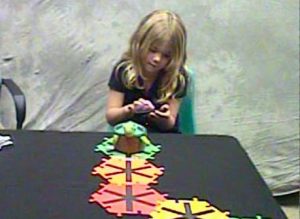[ad_1]
The finding was that, when exposed to a computer-programming activity, six-year-old girls expressed greater interest in technology and more positive attitudes about their own skills and abilities than girls who didn’t try the activity.
According to researcher Allison Master, the results suggest both a need and an opportunity for teaching computer science, in particular, in early elementary school.
“As a society, we have these built-in beliefs that are pushing boys toward certain activities more than girls. So our thought was, if you give equal experiences to boys and girls, what happens?,” asked Master. “We found that if you give them access to same opportunities, then girls and boys have the same response – equal interest and confidence.”
The study, published in the Journal of Experimental Child Psychology, involved a survey designed to collect kids’ opinions of technology activities, like the robot, and their beliefs about whether girls or boys are better at computer programming and robotics.
It involved 96 six-year-olds, evenly divided among boys and girls, who were randomly assigned one of three groups. In the first group, each child programmed a robot, then answered survey questions; in the second group, each played a storytelling card game, then answered the same questions, while those in the third group only answered the questions.
Programming, the researchers explained to the children, is “when you tell a computer or a robot or a phone what to do.”
For the robot activity, children chose an animal-like robot. They first followed step-by-step instructions on a phone to ‘tell’ it to move forward, backward, right or left, then chose the instructions themselves, effectively programming the phone to control the movements of the robots.
After completing the robot activity, the boys and girls showed equal interest in technology and their own feelings of self-efficacy, or confidence in their own abilities.
The control group played the card game, or only answered the survey without playing a game. “The difference was striking: the designed activity with the robot reduced the gender gap in technology interest by 42%, and the gap in self-efficacy by 80%,” said the University. “In other words, girls who programmed the robot were much more likely to express interest in programming and confidence in their own abilities to perform technology-related tasks than the girls who didn’t work with the robot.”
Experience in programming the robot movement was something that both boys and girls thought was fun, and it brought the girls’ interest and motivation in STEM up to the level of the boys.
“The important thing is to make activities accessible to all children in a fun way that also helps them build skills,” said Master.
The study’s robot activity did not appear to change the children’s stereotypes about whether boys or girls are better at programming and robotics. While the girls who programmed the robot indicated greater confidence in their own abilities, that confidence did not alter their stereotypes
“Stereotypes get built up in our heads from many different sources and experiences, but perhaps if we give girls more experience doing these kinds of activities, that will give them more resources to resist those stereotypes,” Master said. “They might be able to say, ‘I can still be good at this and enjoy it, despite the cultural stereotypes.’”
[ad_2]
Source link

